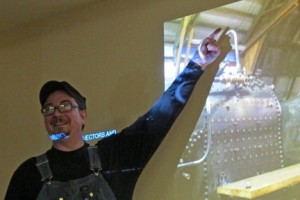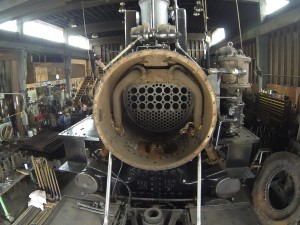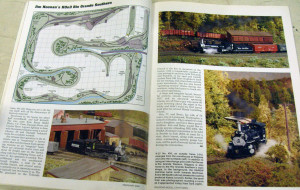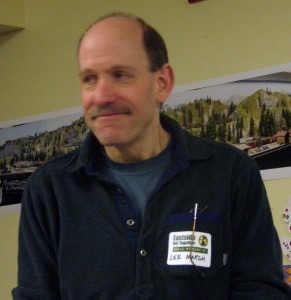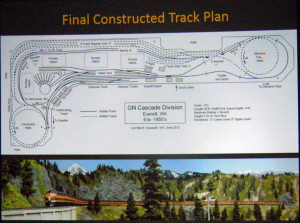CJ Riley has moved to Port Ludlow and wants to meet 4D members in the Port Townsend area. Contact him at 360.327.8003, or cjriley42@yahoo.com.
Grab Iron Posts
Seattle-North Clinic – Come “See” Us on April 3, 2014
By Jeff Moorman
Please join us for our next meeting on Thursday, April 3, 2014. Our clinic will be a discussion of “Vision and the Aging Model Railroader”. It will cover how the eye functions, the basic effects of aging on the eyes, how those effects might impact model railroading, and what can be done to mitigate those effects.
Last month our planned guest speaker (on collecting brass) wasn’t available. Dennis T saved the day by making arrangements for us to view the YouTube video on moving UP Big Boy #4014 from a park display in Pomona, California to the UP yard in Colton. Eventually it will be moved to the Cheyanne shops for restoration.
First they pulled it off its display track and moved it across a big parking lot using panel track. Then, at night, a connection to the nearby mainline was made to pull the locomotive out across what appeared to be an impossibly sharp curve and drag it to Colton. Of course, the mainline had to be operational the next morning. If you get a chance to see this, I think you will find it interesting.
For show and tell Dennis T brought along several pieces of N scale rolling stock with scratch built loads. You can see them in the photos below:
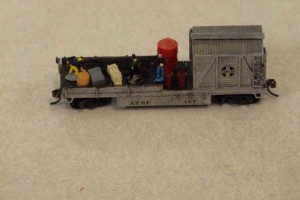

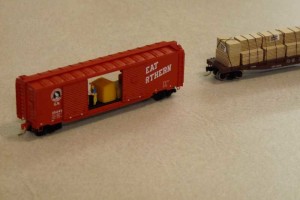
We meet at the Ronald United Methodist Church, 17839 Aurora Avenue North, Shoreline, WA. That is on the west side of Aurora (State Route 99) between 175th and 185th Streets and more specifically, between the Cadillac dealer on the south and Deseret Industries to the north. Going southbound on Aurora, make a right-hand turn into the church driveway immediately after passing the Deseret location. The parking lot is at the rear of the church. For regular meetings enter the lower, left side of the church from the rear lot.
Meetings are the first Thursday of each month, September through June. However in June we often do something different, like a layout tour. Doors open around 7:00 PM and the program starts at 7:30.
Remember the next meeting is April 3. The meeting after that is May 1. Hope to see you there or at least sometime on down the line.
4th Division Education Committee Needs Volunteers
Alex Brikoff
The 4th Division Education Committee is in need of volunteers to work on the 4th Division Video Library. Stu Rogers, the current video librarian, is stepping down and would like to turn the video library over to someone else. The Education Committee will be taking charge of the library and making some improvements to the service coverage as well as the efficiency of the library. Here’s our plan:
The 4th Division Education Committee has several projects that it will be working on over the next several months. Improving the Video Library is one of them.
1. Find a new Video Library Chairman to work with me to find three additional dedicated volunteers to administer the library. The new video library chairman will take over Stu’s current duties that will include the following:
b. Maintenance of the library to insure there is no damage to the media when returned.
c. Maintain an online method of tracking checkouts and checkins of videos and DVDs.
d. Do periodic research and acquire new movies to keep the collection “fresh” and up to date as necessary within allocated budget.
e. Any other duties that may come up pertaining to the Video Library including communicating with the other three video librarians and setting up a way of transferring videos from a central location.
2. These four volunteers should be able to meet the following requirements:
b. Have dependable transportation.
c. Be able to attend local clinics in their respective areas.
d. Have an email account and at least a basic computer proficiency and software knowledge, such as Microsoft Office.
3. Each of these four video librarians should live in each of the four geographic directions with Seattle being at the center. By this I mean, one should live north of Seattle, another east of Seattle and the third and fourth should live in the other two directions respectively.
If you would like to be a part of this project and participate in this 4th Division opportunity, or just to find out more about it, please contact me, 425-466-1490 or abrikoff@frontier.com.
Skagit Valley and Whidbey Clinic March 2014 Report
by Rich Blake / Photos by Al Frasch
We kicked off the March clinic with a short discussion on recent and upcoming events. One recent event of note was the 10th Annual Pacific Model Loggers Congress at the Camp 18 Restaurant in Elsie Oregon held March 2nd. Rich Blake attended the meet and gave a report on some of the fun things to see and do in that part of the country especially the vast collection (his words “butt-ton”) of logging equipment on the Camp 18 property. It is a great place to go if you are researching logging history and would like to view and inspect prototype equipment. e also did our duty and reminded everyone about the Regional PSX Tacoma Event in June.
This clinic was very special in that our feature clinician was none other than the Chief Mechanical Officer of the Mount Rainier Scenic Railroad – Stathi Pappas. His clinic, titled “Steam Locomotive Systems and Technology” was a fascinating look into the inner workings of steam locomotives and how you can apply the prototype’s systems to more accurate modeling. Stathi is not only a vast storehouse of knowledge as one of the few people in the US that has rebuilt several steam locomotives for operation, he is also an adept and entertaining speaker. We got to hear quotes like “Why would anyone want to burn goofy black rocks??” in reference to coal locos and “Baldwin was the Ford of locomotive builders” you can guess what that means.
Stathi enforced the point that understanding locomotive systems is key to proper detailing on models. He talked about the difference between “Superdetailing” and “Stuperdetailing” where in the latter example too much stuff does not a better model make if it doesn’t make sense with the rest of the systems. He used several photos to describe the various systems and how they operate. More importantly he also described “why” things are the way they are on the various locomotives. Sometimes it is aesthetics and sometimes it is function with the point being that every time a locomotive came out of a repair or rebuild cycle, it was always different than when it went in. We got into a lot of specifics and it was a very interesting discussion with many club members asking a lot of questions about loco systems. Stathi covered many detailed topics including:
All of the photos Stathi used were of MRSR locomotives and his own personal locomotive – the “Chiggen” a former Santa Cruz Portland Cement Porter 0-4-0T that Stathi rebuilt from the ground up including fabricating a new boiler. (see more on this loco here: www.scpc2.com) The pictures themselves were amazing in that they detailed many areas of locomotives during the rebuild phase that are not normally seen in finished form.
He concluded the presentation by reiterating the fact that understanding the systems and knowing that everything on a loco is the way it is for a reason makes for better modeling and it is all up to the modeler as to how far they want to go with their individual detailing. He then spent another hour answering questions of which there was a plethora. Overall it was one of the best and most informative prototype clinics we have ever had. Hats off to Stathi for taking the time and allowing us the opportunity to dive into and learn about the fascinating subject of steam locomotive technology with a true expert in the field.
If you would like to see some of Stathi’s projects in action then come out to the Mount Rainier Scenic Railroad this May 17th for the special “Steam Up” event. The goal is to have no less than six operating steam locomotives running for photo shoots and run bys. This should be a “must do” event for any steam fan and especially any of us in the Pacific Northwest since it is virtually in our back yard. Check out the schedule at www.mrsr.com.
Eastside Get Together February Meeting
JJ Johnston
Once again our enthusiastic Eastside Get-Together chief honcho, JJ Johnston, welcomed about 50 attendees to the February meeting. He introduced/recognized the officers and committee chairs of the 4th Division in attendance as well as the MMRs. Don and Beth MacLaren did a great job filling in for our Welcome Ambassador Clay Hanson with making sure everyone had a name tag and ballot for the Model of the Month and door prize drawings.
We had several new attendees with us: Mike Dziubinski modeling in N Scale; Pete Murphy modeling in HO Scale; Jim Linden modeling in HO Scale; Richard Moore modeling in HO Scale; Craig Jackson modeling in High-Rail; Lee and Nancy Marsh modeling in HO Scale. Lee will be presenting our clinic later.
Announcements were by: Rob Jones, 4D Membership Chair, described some new ideas to promote membership such as having a “membership chair” in each clinic and doing clinics at libraries or other venues; Jim Sabol touting the release of the new DVD West Coast Railroad Logging that he helped put together selling for $25 cash or $29.95 check (this is the DVD he talked about several months ago and treated us to some of the old movies being used in the DVD) and reminded everyone of the upcoming annual logging event in Elsie, Oregon; Bob Rorabaugh telling about the swap meet in Chehalis March 29 and 30; David Yadock thanking everyone who attended and/or helped out with the PSC show which had over 12,500 attendees for the 3-day weekend show and that the Science Center staff will be working to get things rolling earlier for next year in the way of announcements and posters and that he would like to see more smaller layouts made available to spread around the Science Center for more variety (all scales are welcome!); Roger Ferris commented that the last of the PFM materials were available in the Mart; Russ Segner mentioned that Joe Fugate, of Model Railroad Hobbyist, would be the speaker at the Convention banquet in June and that the election of two officers for 4D were coming up and, if you wanted to run for either of these two positions, to contact Mike Highsmith or himself.
Model of the Month had four “entries”: David Yadock with an A-B set of Santa Fe F-3s found on his shelf and added a decoder, working Mars light, marker lights and a tune-up; Bobj Berger displayed an RMC article on Jim Noonan’s layout stating that the layout was available for sale and can be moved since it was built in sections; Bob Rarabaugh displayed “PUM”(Piles of Unusable Material) or a slash burn pile that he had made; Russ Segner displayed his “scratch built in no scale” cash donation box for the Bellevue library using mahogany, but had to build a bigger one. And the winner was … Bob Rarabaugh with his pile of trash!
Di Voss was asked to report on his evaluation of using “Bull Frog Snot” for traction on one of his engines. He applied it to a ten-wheeler which before application 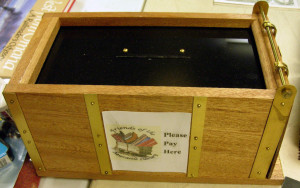 could pull 2 cars up a 2 ½% grade. After the application the ten-wheeler could pull 6 cars up the 2 ½% grade! He applied the “Snot” to only the gear-driven driver. He said it worked just like a rubber tire on the wheels.
could pull 2 cars up a 2 ½% grade. After the application the ten-wheeler could pull 6 cars up the 2 ½% grade! He applied the “Snot” to only the gear-driven driver. He said it worked just like a rubber tire on the wheels.
After our break, Lee Marsh gave us a wonderful presentation on the construction of his layout, “Head of the
Rake – GN Cascade Division” in HO Scale.The layout is basically an L shape 12 feet wide at the base of the L and 32 feet long, built 51 inches from the floor with a 24” minimum radius. Being a civil engineer, the benchwork is very solid but includes some unique access hatches to get to hard to reach locations. Lee and his wife Nancy moved to WashingtonState in the 1980s and began exploring the StevensPass area where they encountered the BN line over the Cascades. All this scenery and complexity of getting the railroad through the mountains solidified the idea that he wanted to build a mountain railroad. He began developing a layout plan in the mid-1990s and knew he wanted a main line run through the mountains. He liked the late steam and early diesel equipment and eventually ended up on the 1951 time frame. Knowing he couldn’t include faithful reproductions of the features along the GN line he decided to freelance using Everett and the GN main line over the Cascades. He started construction in 1996 and figures it’s about 80% complete today.
The layout includes five staging tracks underneath the upper level permitting staging of the primary trains and two three-track stub yards for staging of local trains. The upper level is reached via two helices. One is near the end of Delta Yard in Everett and the other is at the other end of the layout going toward what would be StevensPass if the layout continued that far.
The scenery is hard shell which provides space beneath for the staging. The backdrop Is hand-painted from photographs taken in June north of Skykomish. Since this is mountainous territory there are a number of bridges and trestles all of which are excellently done. Naturally, there has to be a lot of trees of all sizes and shapes and Lee has been fortunate to find a company that can make any kind of tree he needs. When you see pictures of the layout, you really feel like you’re in the Cascades!
One week later, on Saturday March 1, Lee held a private open house of his layout exclusively for those who had attended his Thursday Eastside presentation. Very impressive and stunning scenery. Assisted by Mike Dziubinski, the trains ran very well and it was a great time for everyone to be able to spend some time admiring Lee’s work.
Lee will return to the Eastside monthly meeting on April 17 to present a clinic on the use of Helicon Focus, a software program which creates incredible depth of field photographs. Attendees will be invited to bring their cameras and use them in actual situations. Watch for more information.
Got Room For a Model Masterpiece?
Bobj Berger
Check out an article in the Everett HeraldNet interviewing me (Bobj) about Jim Noonan’s layout titled:
Tacoma Clinic
Al Babinsky
MMR Gene Swanson opened the clinic on time with 34 in attendance; we did not have any newcomers in the crowd. Russ Segner was introduced as the new 4D super and told about his work at the Snoqualmie museum and at the DuPont museum. The DuPont museum has the only narrow gauge railroad in this area; it is a 2 foot gauge.
Mike Highsmith is the assistant super and is in charge of the nomination committee for the upcoming elections and asked that everyone vote when the ballots arrive.
The Tacoma Clinic layout tours will be held on May 10th with the layouts grouped, 5 are in the Tacoma area and 4 in the federal Way area. The Tacoma tour is in the morning and the Federal Way tour in the afternoon with a lunch break in between to allow for time to transition between the two areas.
There was an announcement about the Mount Rainier Scenic RR having a steam up of 5 locomotives plus one guest locomotive on May17th.
The IPMS (International Plastic Modelers Society) has a spring show at the Renton Community Center on April 12. For information on the go to their website at: http://www.ipms-seattle.org/springshow
What’s new at the hobby shop presented by Bill Sandstrom of Tacoma Trains, there were a number of items from Athearn, Walthers, Kato, Microtrains, and Wheels of Time.
The Bring and Brag had several entries, Scott Taylor brought his scratch built track models that were built for his civil AP certificate, and they consisted of a #5 RH turnout, a 90 degree crossing and a gauntlet track. He used downloaded drawings from “Fast Tracks” which are available from their website. Chris Clancey brought a GP-38 that he painted for the Weyerhaeuser logging RR; Russ Segner brought a laser cut kit for a repair shop that is a project in progress. Walt Huston had an N scale diorama. Scott Taylor won the Bring and Brag award.
After the break MMR Gene Swanson and Mike Shaw presented this month clinic on basic scenery. The presentation was made with a diorama showing the how it was done by using a video camera and a wall mounted monitor. They also had photos of Gene’s layout where you could see the final result. A very informative clinic with a great handout and of course the use of video and photos. I will have the handout as well as some of the photos attached to this report.
Next month clinic will be on the AP program and is presented by Jack Hamilton. The clinic will be at our usual place in the Pierce County Library Admin. Bldg. at the corner of 112th street and Waller Road at 7:30PM, hope to see you there.
Seattle-North Clinic Talks about Brass – March 6, 2014
By Jeff Moorman
Please join us for our next meeting on Thursday, March 6, 2014. Our guest speaker will be a railroad enthusiast and brass collector.
If you weren’t there for last month’s guest speaker, you missed a very interesting and entertaining evening. Dave Honan is a civil engineer for HDR here in Seattle and he specializes in railroad and transit design in 12 inches to the foot scale. We also discovered he is an excellent railroad photographer and slide show producer.
Dave talked about some projects he’s been involved with which varied from coal hauling railroads across the Great Plains to local transit works. Hearing about everything he has had to deal with was fascinating. He mentioned lots of things I had never considered before. Here are a couple:
When you plan the route of a railroad in varied terrain, not only do you need to look for a pretty steady grade, but you should match the volume of material in cuts to the volume of material used for fills. That cuts down on earth “moving” costs.
Another item of design concerns coping with grades that have curvature. A curve adds drag to the train. So if you have a big curve in the middle of a long grade, when the train rounds that curve it till get harder to pull. The prototype solution is to reduce the grade through the curve, so there is a more consistent drag. For example, consider a long 2% grade with a 90 degree curve in the middle. The basic grade might be designed at 2.25% with a reduction to 1.5% through the curve in order to even out the motive power effort required to get to the top of the hill.
Dave finished out the evening by showing a couple of photo presentations he has done. My favorite included scenes from a narrow gauge peat railroad in Ireland (I think).
For show and tell Dennis T brought along an N scale model of a U-50 locomotive. He had added a decoder to the older loco, which was quite heavy. He said it pulls like gangbusters.
I brought along a kit for the Penryn Fruit Company. This is a small wood HO structure that will be the standard kit for a special contest at the regional convention in June. Everyone in the contest builds the same kit using the same basic rules. You can find out more on the convention’s website – http://www.wnrr.net/PSX2014/contests.html. Now that I have the kit I guess I shall have to build it, especially since it looks pretty straightforward.
We meet at the Ronald United Methodist Church, 17839 Aurora Avenue North, Shoreline, WA. That is on the west side of Aurora (State Route 99) between 175th and 185th Streets and more specifically, between the Cadillac dealer on the south and Deseret Industries to the north. Going southbound on Aurora, make a right-hand turn into the church driveway immediately after passing the Deseret location. The parking lot is at the rear of the church. For regular meetings enter the lower, left side of the church from the rear lot.
Meetings are the first Thursday of each month, September through June. However in June we often do something different, like a layout tour. Doors open around 7:00 PM and the program starts at 7:30.
Remember the next meeting is March 6. The meeting after that is April 3. Hope to see you there or at least sometime on down the line.
Nomination Deadline this Friday, 3/7
Michael Highsmith, 4D Nominating Committee Chair
The 4D Board of Directors is seeking new members to fill the posts of Director 1 and Superintendent. Each is a two-year term commencing in August 2014.
Email me or the other committee members, Scott Buckley or Jeff Moorman with your name, the position you seek and a 250-300 word Candidate Statement by March 7.
Ballots will be sent by April 15.
Ross Jacobus, 1925 – 2014
Bob Rorabaugh
Ross Jacobus, long time model railroader, died on January 26, 2014 in Port Townsend, near three of his four daughters and their families.
Our Port Townsend NMRA guys rolled out a welcome carpet. John Colley in particular picked him up Wednesday evenings and took him to the club where, to the sound of running trains, Ross would sometimes drift off to dream a spell.
Ross had doted on two special wives, out-living both. He was loved by his girls, all four of them now in their fifties. The words they used of him: intelligent, curious, willing, humble, humorous, honorable, kind and “always there for us.” The memories of our North Seattle and Eastside clinicians include “always that smile,” “most awesome host with refreshments,” “willing to help or explain if asked,” and “crazy hair.”
He once asked this ol’ farm boy to prune his fruit trees, then paid me with a Bachmann HO Doodlebug. While pruning, I lost a spring from my small clippers and knew I’d never find it in the weeds and grass. Then, several Sundays later I noticed Ross walking through the church’s lobby with a spring in his step. Was that my spring? He just smiled at me.
Ross apparently didn’t “teach” his daughters the “what” he knew about loving God, spouse, family and work. Instead, he modeled the “who” he knew. He fleshed out many of the qualities of God’s relational love of His people. I asked his family to have a chat with their absent dad. “How do you like where you are now?” and “Would you mind if we leaned into the same heavenly Father’s love?” “Oh and tell our mom we’re coming, too.”


